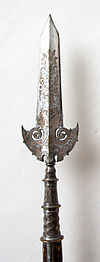Partisan
| Partisan | |
|---|---|

|
|
| Information | |
| Weapon type: | Polearm |
| Designations: | Spontaneous |
| Use: | Weapon of war |
| Creation time: | 15th century |
| Working time: | 15th to 18th century |
| Region of origin / author: |
Italy |
| Distribution: | Europe |
| Overall length: | up to about 250 cm |
| Handle: | Wood, leather |
| Particularities: | various equipment, blade sizes and shapes |
| Lists on the subject | |
A partisan is a thrust weapon and is one of the pole weapons . It was in use from the 15th to the 18th centuries.
origin
The partisan was first recorded in Italy in the 15th century. The Italian name partigiana is derived from partigiano ( partisan , actually "partisans"). Another is the derivation of the Italian pertugiare , which means to pierce .
In terms of weapon technology, the partisan probably developed from the ox tongue or the booze pen (gag spit) or the winged lance . From the second quarter of the 16th century the partisan gradually became a parade and guard weapon , and around 1600 it was also used as an officer's weapon . As such, it remained in use in the form of the spontaneous partisans until the beginning of the 19th century.
description
The partisan is approx. 2.1 - 2.8 m long, of which approx. 0.6 - 0.8 m is accounted for by the attachment, which consists of the blade and nozzle . The shaft is made of sturdy wood and carries the attachment that is forged from one piece. The paper consists of a wide, symmetrical, double-edged, tapering central blade and two curved side blades, the ears. The side blades are less massive than the middle blade and are reminiscent of a lying crescent from which the middle blade protrudes. If the side blades are reduced to their roots , they are called chopped ears .
With the two side blades it is possible, if used skillfully, to disarm the enemy or to pinch his weapon. In addition, the two side blades prevent the partisans from penetrating too deeply into the enemy, which makes it easier to pull out the weapon. The sturdy and massive attachment allows the user to penetrate light to medium armor .
Usage today
Today partisans are only used as parade weapons and ceremonial weapons. For example, the Yeomen of the Guard , the ceremonial bodyguards of the British monarch and the Swiss Guard of the Holy Apostolic See still wear the partisans in full historical clothing.
It is named after the partisan in the Partisan Guard of Hall in Tirol , an honor guard that accompanies the Holy of Holies during processions through the city of Hall .
Swiss guards with partisans (right) and halberds (left)
Partisans of the Partisan Guard in Hall in Tirol
Web links
Individual evidence
- ↑ See Duden online: Partisan and Partisan
- ↑ a b c Gerhard Seifert: Technical terms of edged weapons. German ABC of the European naked defensive weapons. (Cut, thrust, hit and hand thrown weapons). Verlag Seifert, Haig 1981.
- ↑ Peter Krenn : Sword and Spit. Landeszeughaus Graz at the Styrian State Museum Joanneum. German English. Kunstverlag Hofstetter, Ried im Innkreis 1997, p. 62.
- ^ Jean-Denis GG Lepage: Medieval Armies and Weapons in Western Europe , McFarland Verlag, 2014, ISBN 9780786462513 , p. 105 [1]




